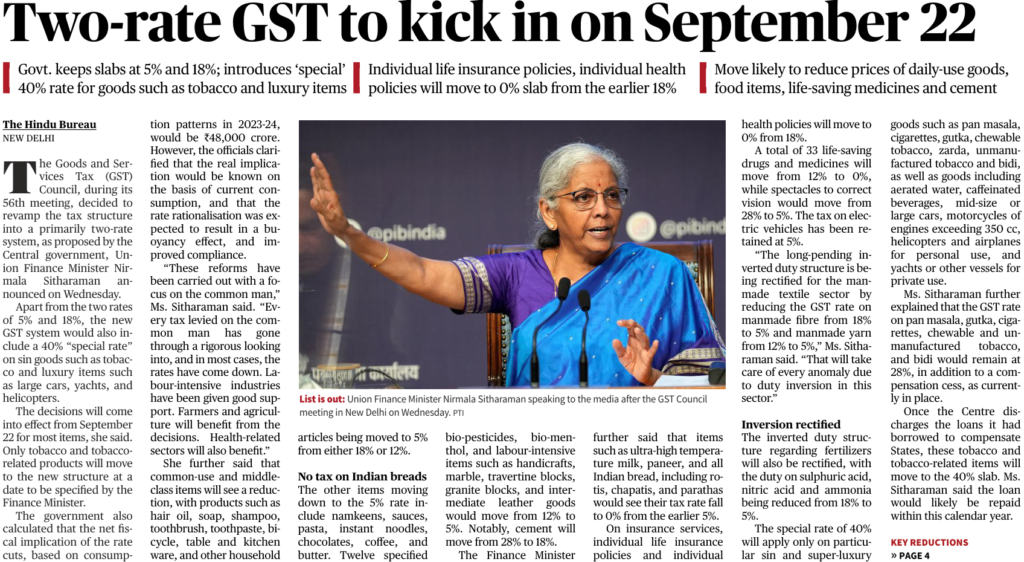ISSUE – 22GST Reforms 2025 |
UPSC Mains Exam Oriented Practice Questions
QUESTION 01
To what extent will the latest GST reforms, often called “GST 2.0”, reach consumers? What impact will the new two-slab structure and other reforms have on the fast-moving consumer goods (FMCG) sectors? (GS – III, 10 Marks, 150 Words)
QUESTION 02
Discuss the possible new federal tensions that might arise from the GST reforms, especially concerning state revenues and compensation mechanisms? (GS – II, 10 Marks, 150 Words)
Key Sources for Writing Answers
Key Sources for Writing Answers
News Article on PIB
Recommendations of the 56th Meeting of the GST Council
The 56th meeting of the GST Council was held in New Delhi under the chairpersonship of the Union Finance & Corporate Affairs Minister Smt. Nirmala Sitharaman. The GST Council inter-alia made the recommendations relating to changes in GST tax rates, provide relief to individuals, common man, aspirational middle class and measures for facilitation of trade in GST.
Key Points
- Next-generation GST reforms, as announced by Prime Minister Shri Narendra Modi from the ramparts of Red Fort on 15th August 2025, represent a strategic, principled, and citizen-centric evolution of a landmark tax framework, which will enhance the quality of life of every last citizen
- GST Council approves reforms with a multi-sectoral and multi-thematic focus on improving the lives of all citizens and ensuring ease of doing business for all, including small traders and businessmen
- GST Council approves rate rationalisation with a focus on Common-man, Labour-intensive Industries, Farmers and Agriculture, Health, Key Drivers of the economy
- Exemption of GST on all individual life insurance policies whether term life, ULIP or endowment policies and reinsurance thereof to make insurance affordable for the common man and increase the insurance coverage in the country.
- Exemption of GST on all individual health insurance policies (including family floater policies and policies for senior citizens) and reinsurance thereof to make insurance affordable for the common man and increase the insurance coverage in the country
- Rationalisation of the current 4-tiered tax rate structure into a citizen-friendly ‘Simple Tax’ – a 2 rate structure with a Standard Rate of 18% and a Merit Rate of 5%; a special de-merit rate of 40% for a select few goods and services
- Reduction of GST from 18% OR 12% to 5% on a host of common man items such as, hair oil, toilet soap bars, shampoos, toothbrushes, toothpaste, Bicycles, Tableware, kitchenware, other household articles, et al
- Reduction of GST from 5% to NIL on Ultra-High Temperature (UHT) milk, Prepackaged and labelled chena or paneer; All the Indian Breads will see NIL rates (Chapati or roti, paratha, parotta, etc)
- Reduction of GST from 12% OR 18% to 5% on almost all of the food items such as packaged namkeens, Bhujia, Sauces, Pasta, Instant Noodles, Chocolates, Coffee, Preserved Meat, Cornflakes, Butter, Ghee, etc.
- Reduction of GST from 28% to 18% on Air-conditioning machines, TVs~32 inch (all TVs now at 18%), Dishwashing machines, Small cars, Motorcycles equal to or less than 350 CC
- Reduction of GST from 12% to 5% on agricultural goods, such as tractors, agricultural, horticultural or forestry machinery for soil preparation or cultivation, harvesting or threshing machinery, including straw or fodder balers, grass or hay mowers, composting machines etc
- Reduction of GST from 12% to 5% on labour intensive goods such as Handicrafts, Marble and travertine blocks, granite blocks, and Intermediate leather goods
- Reduction of GST from 28% to 18% on Cement
- Reduction of GST from 12% to NIL on 33 lifesaving drugs and medicines and from 5% to NIL on 3 lifesaving drugs & medicines used for treatment of cancer, rare diseases and other severe chronic diseases.
- Reduction of GST on all other drugs and medicines from 12% to 5%.
- Reduction of GST from 18% to 5% on various medical apparatus and devices used for medical, surgical, dental or veterinary usage or for physical or chemical analysis
- Reduction of GST from 12% to 5% on various medical equipment and supplies devices such as wadding gauze, bandages, diagnostic kits and reagents, blood glucose monitoring system (Glucometer) medical devices, etc
- Reduction of GST from 28% to 18% on Small Cars and Motorcycles equal to or below 350cc
- Reduction of GST from 28% to 18% on buses, trucks, ambulances etc
- Uniform rate of 18% on all auto parts irrespective of their HS code; Three-Wheelers from 28% to 18%
- Correction of long-pending inverted duty structure for the manmade textile sector by reducing GST rate on manmade fibre from 18% to 5% and manmade yarn from 12% to 5%
- Correction of inverted duty structure in fertilizer sector by reducing GST from 18% to 5% on Sulphuric acid, Nitric acid and Ammonia
- Reduction of GST from 12% to 5% on renewable energy devices and parts for their manufacture
- Reduction of GST from 12% to 5% on “Hotel Accommodation” services having value less than or equal to Rs. 7,500 per unit per day or equivalent
- Reduction of GST from 18% to 5% on beauty and physical well-being services used by common man including services of gyms, salons, barbers, yoga centres, etc
- GST Council recommends operationalisation of Goods and Services Tax Appellate Tribunal (GSTAT) for accepting appeals before end of September and to commence hearing before end of December 2025
- GST Council recommends GST rates on services will be implemented with effect from 22nd September 2025
News Article on THE HINDU

Practice Questions on Previous Issues
| India and UK Sign Comprehensive Economic and Trade Agreement (CETA) |
ISSUE – 12 |
| ISSUE – 11 The United States to designate The Resistance Front (TRF) as a Foreign Terrorist Organization (FTO) |
| ISSUE – 10 Three Language Policy |
